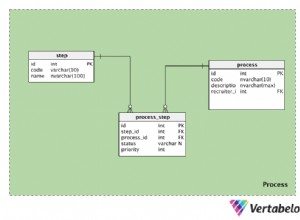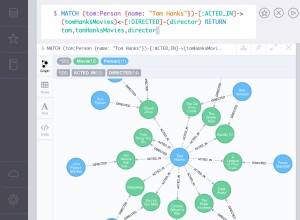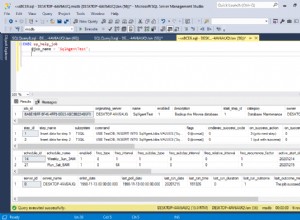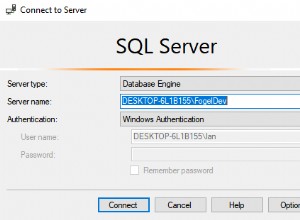Đây là một ví dụ đầy đủ. Đầu tiên, DDL :
test=> CREATE TABLE node (
test(> id SERIAL,
test(> label TEXT NOT NULL, -- name of the node
test(> parent_id INT,
test(> PRIMARY KEY(id)
test(> );
NOTICE: CREATE TABLE will create implicit sequence "node_id_seq" for serial column "node.id"
NOTICE: CREATE TABLE / PRIMARY KEY will create implicit index "node_pkey" for table "node"
CREATE TABLE
... và một số dữ liệu ...
test=> INSERT INTO node (label, parent_id) VALUES ('n1',NULL),('n2',1),('n3',2),('n4',3);
INSERT 0 4
test=> INSERT INTO node (label) VALUES ('garbage1'),('garbage2'), ('garbage3');
INSERT 0 3
test=> INSERT INTO node (label,parent_id) VALUES ('garbage4',6);
INSERT 0 1
test=> SELECT * FROM node;
id | label | parent_id
----+----------+-----------
1 | n1 |
2 | n2 | 1
3 | n3 | 2
4 | n4 | 3
5 | garbage1 |
6 | garbage2 |
7 | garbage3 |
8 | garbage4 | 6
(8 rows)
Điều này thực hiện một truy vấn đệ quy trên mọi id trong nút:
test=> WITH RECURSIVE nodes_cte(id, label, parent_id, depth, path) AS (
SELECT tn.id, tn.label, tn.parent_id, 1::INT AS depth, tn.id::TEXT AS path
FROM node AS tn
WHERE tn.parent_id IS NULL
UNION ALL
SELECT c.id, c.label, c.parent_id, p.depth + 1 AS depth,
(p.path || '->' || c.id::TEXT)
FROM nodes_cte AS p, node AS c
WHERE c.parent_id = p.id
)
SELECT * FROM nodes_cte AS n ORDER BY n.id ASC;
id | label | parent_id | depth | path
----+----------+-----------+-------+------------
1 | n1 | | 1 | 1
2 | n2 | 1 | 2 | 1->2
3 | n3 | 2 | 3 | 1->2->3
4 | n4 | 3 | 4 | 1->2->3->4
5 | garbage1 | | 1 | 5
6 | garbage2 | | 1 | 6
7 | garbage3 | | 1 | 7
8 | garbage4 | 6 | 2 | 6->8
(8 rows)
Điều này nhận được tất cả các con trỏ WHERE node.id =1:
test=> WITH RECURSIVE nodes_cte(id, label, parent_id, depth, path) AS (
SELECT tn.id, tn.label, tn.parent_id, 1::INT AS depth, tn.id::TEXT AS path FROM node AS tn WHERE tn.id = 1
UNION ALL
SELECT c.id, c.label, c.parent_id, p.depth + 1 AS depth, (p.path || '->' || c.id::TEXT) FROM nodes_cte AS p, node AS c WHERE c.parent_id = p.id
)
SELECT * FROM nodes_cte AS n;
id | label | parent_id | depth | path
----+-------+-----------+-------+------------
1 | n1 | | 1 | 1
2 | n2 | 1 | 2 | 1->2
3 | n3 | 2 | 3 | 1->2->3
4 | n4 | 3 | 4 | 1->2->3->4
(4 rows)
Phần sau sẽ lấy đường dẫn của nút có id 4:
test=> WITH RECURSIVE nodes_cte(id, label, parent_id, depth, path) AS (
SELECT tn.id, tn.label, tn.parent_id, 1::INT AS depth, tn.id::TEXT AS path
FROM node AS tn
WHERE tn.parent_id IS NULL
UNION ALL
SELECT c.id, c.label, c.parent_id, p.depth + 1 AS depth,
(p.path || '->' || c.id::TEXT)
FROM nodes_cte AS p, node AS c
WHERE c.parent_id = p.id
)
SELECT * FROM nodes_cte AS n WHERE n.id = 4;
id | label | parent_id | depth | path
----+-------+-----------+-------+------------
4 | n4 | 3 | 4 | 1->2->3->4
(1 row)
Và giả sử bạn muốn giới hạn tìm kiếm của mình trong phạm vi con cháu có depth ít hơn ba (lưu ý rằng depth vẫn chưa được tăng lên):
test=> WITH RECURSIVE nodes_cte(id, label, parent_id, depth, path) AS (
SELECT tn.id, tn.label, tn.parent_id, 1::INT AS depth, tn.id::TEXT AS path
FROM node AS tn WHERE tn.id = 1
UNION ALL
SELECT c.id, c.label, c.parent_id, p.depth + 1 AS depth,
(p.path || '->' || c.id::TEXT)
FROM nodes_cte AS p, node AS c
WHERE c.parent_id = p.id AND p.depth < 2
)
SELECT * FROM nodes_cte AS n;
id | label | parent_id | depth | path
----+-------+-----------+-------+------
1 | n1 | | 1 | 1
2 | n2 | 1 | 2 | 1->2
(2 rows)
Tôi khuyên bạn nên sử dụng ARRAY kiểu dữ liệu thay vì một chuỗi để thể hiện "đường dẫn", nhưng mũi tên minh họa nhiều hơn về mối quan hệ <=> con.




